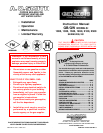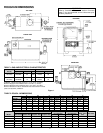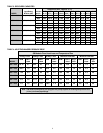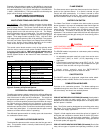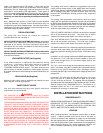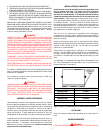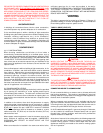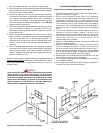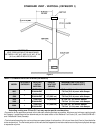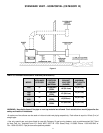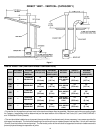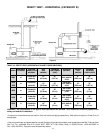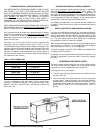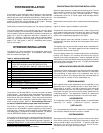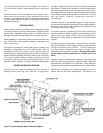
4
PRECAUTIONS
IF THE UNIT IS EXPOSED TO THE FOLLOWING, DO NOT
OPERATE UNTIL ALL CORRECTIVE STEPS HAVE BEEN MADE
BY A QUALIFIED SERVICEMAN:
1. EXPOSURE TO FIRE.
2. IF DAMAGED.
3. FIRING WITHOUT WATER.
4. SOOTING.
IF THE BOILER HAS BEEN EXPOSED TO FLOODING, IT MUST BE
REPLACED.
LIQUID PETROLEUM MODELS
Boilers for propane or liquefied petroleum gas (LPG) are different
from natural gas models. A natural gas boiler will not function
safely on LP gas and no attempt should be made to convert a
boiler from natural gas to LP gas.
LP gas must be used with great caution. It is highly explosive and
heavier than air. It collects first in the low areas making its odor
difficult to detect at nose level. If LP gas is present or even
suspected, do not attempt to find the cause yourself. Leave the
building, leaving doors open to ventilate, then call your gas supplier
or service agent. Keep area clear until a service call has been
made.
At times you may not be able to smell an LP gas leak. One cause
is odor fade, which is a loss of the chemical odorant that gives LP
gas its distinctive smell. Another cause can be your physical
condition, such as having a cold or diminishing sense of smell
with age. For these reasons, the use of a propane gas detector is
recommended.
IF YOU EXPERIENCE AN OUT OF GAS SITUATION, DO NOT TRY
TO RELIGHT APPLIANCES YOURSELF. Call your local service
agent. Only trained LP professionals should conduct the required
safety checks in accordance with industry standards.
HIGH ALTITUDE INSTALLATION
WARNING
INSTALLATIONS ABOVE 4,500 FEET REQUIRE REPLACEMENT
OF THE BURNER ORIFICES IN ACCORDANCE WITH THE
NATIONAL FUEL GAS CODE (ANSI/NFPA 54). FAILURE TO
REPLACE THE ORIFICES WILL RESULT IN IMPROPER AND
INEFFICIENT OPERATION OF THE APPLIANCE, PRODUCING
CARBON MONOXIDE GAS IN EXCESS OF SAFE LIMITS, WHICH
COULD RESULT IN SERIOUS PERSONAL INJURY OR DEATH.
GENESIS BOILERS ARE EQUIPPED WITH SELF-REGULATING
PREJET ORIFICES WHICH AUTOMATICALLY COMPENSATE FOR
HIGHER ELEVATIONS AND ADJUST THE APPLIANCE'S INPUT
RATE ACCORDINGLY, MAKING IT UNNECESSARY TO REPLACE
ORIFICES FOR HIGH ALTITUDE (UP TO 4,500 FEET ONLY.
CONSULT THE FACTORY FOR HIGHER ALTITUDES.)
Some utility companies derate their gas for altitude. You should
contact your gas supplier for any specific changes which may be
required in your area. Call the local gas utility to verify BTU content
of the gas supplied.
Ratings specified by manufacturers for most boilers apply for
elevations up to 4,500 feet (1350 m). For elevations above 4,500
feet (1350 m) ratings must be reduced by a rate of 4% for each
1,000 feet (300 m) above sea level.
FOREWORD
These designs comply with the latest edition of the American
National Standards for Gas-Fired, Low-Pressure Steam and Hot
Water Boilers, ANSI Z21.13 and CGA 4.9/CGA 3.3 latest edition, as
a low pressure boiler.
Detailed installation diagrams are found in this manual. These
diagrams will serve to provide the installer a reference for the
materials and methods of piping necessary. It is essential that all
water, gas piping and wiring be installed as shown on the diagrams.
You should thoroughly read and understand this manual before
installation and/or operation of this boiler.
The factory warranty will be
void if the boiler(s) have been improperly
installed or operated.
In addition to these instructions, the boiler(s) shall be installed in
accordance with those installation regulations in force in the local
area where the installation is to be made. These shall be carefully
followed in all cases. Authorities having jurisdiction should be
consulted before installations are made.
In the absence of local codes, the installation must comply with
the latest editions.
In the United States:
The National Fuel Gas Code, ANSI Z223.1/NFPA 54 and the National
Electric Code, NFPA 70.
In Canada:
The installation Code CAN/CSA B149.1 and .2 (latest edition) and
the Canadian Electric Code, CSA C22.2.
These are available from the Canadian Standards Association,
8501 East Pleasant Valley Road, Cleveland, OH 44131, USA, or,
Canadian Gas Association Laboratories, 55 Scarsdale Road, Don
Mills, Ontario M3B 2R3, Canada.
GROUNDING INSTRUCTIONS
This boiler must be grounded in accordance with the National
Electrical Code and/or local codes. Boiler is polarity sensitive,
correct wiring is imperative for proper operation.
This boiler must be connected to a grounded metal, permanent
wiring system, or an equipment grounding conductor must be run
with the circuit conductors and connected to the equipment
grounding terminal or lead on the boiler.
WARNING
YOUR BOILER IS NOT DESIGNED TO OPERATE WITH A BOILER
INLET WATER TEMPERATURE OF LESS THAN 120°F (38°C).
COLDER INLET WATER TEMPERATURE WILL RESULT IN
SIGNIFICANT CONDENSATION DEVELOPING ON THE HEAT
EXCHANGER. THIS SITUATION CAN CAUSE A CORROSIVE
ENVIRONMENT FOR THE HEAT EXCHANGER, BURNERS AND
VENTING RESULTING IN PREMATURE DAMAGE, WHICH COULD
RESULT IN SERIOUS PERSONAL INJURY OR DEATH.
FOR SYSTEMS THAT USE LARGE VOLUMES OF COLD WATER
OR SYSTEMS UTILIZING HEAVY WATER DRAWS, CONDENSATION
CAN BE PREVENTED BY USING A BYPASS LOOP.
CORRECT GAS
Make sure the gas on which the boiler will operate is the same as
that specified on the boiler rating plate. Do not install the boiler if
equipped for a different type of gas, consult your gas supplier.



